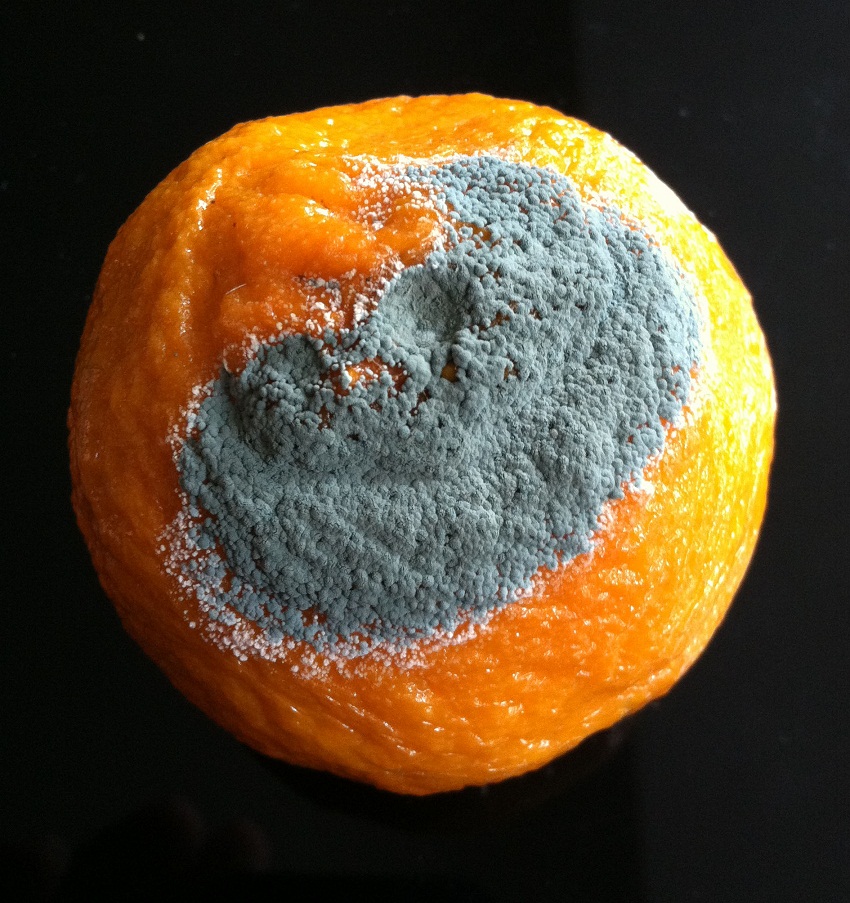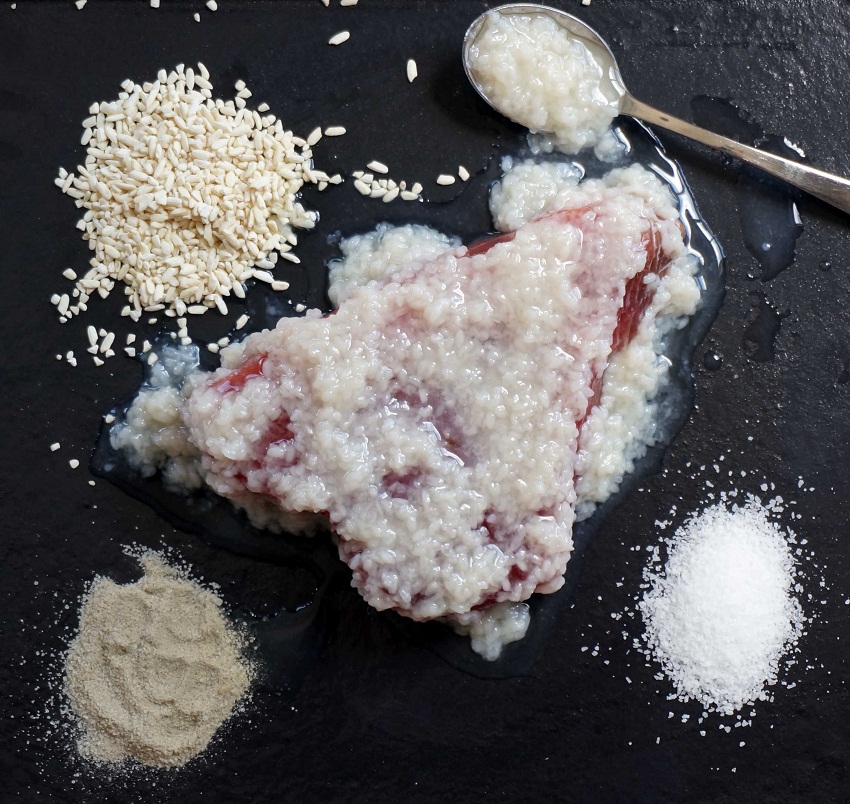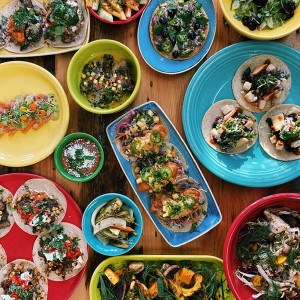Chefology: How Koji—or Mold— Can Become a Marinade
Welcome to Chefology, where married couple Ben Wolfe (a Harvard microbiologist) andScott Jones (the chef de cuisine at No. 9 Park) explore the relationship between biology and haute cuisine. This is, quite literally, a marriage of science and cooking.
We generally associate mold with spoilage. You might think of that lime green loaf of bread in your cupboard. Or the orange in your fruit bowl that’s turned fuzzy and blue. Or maybe you’re feeling bad for the neglected basket of strawberries that grew a moldy beard over the weekend.
Sure, mold can be a food lover’s menace, and a large part of industrialized food production attempts to keep mold away from our food supply. But the rich flavors of some of the most sought after elements of fine dining are brought to you by the power of mold.
Penicillium colonizing an orange.
Mold is a general term used to describe a group of weedy fungi. They’re cousins to the morels and truffles of the fungal world, but molds have given up the complicated and energy-intensive lifestyle needed to make a mushroom. Instead, they spread their fuzzy little filaments (called hyphae) across a food source, produce large masses of spores (those blue, green dusty parts of mold) and move like wildfire through your bread box during a humid summer week. Molds are the dandelions of the fungi.
While molds in the wrong places can lead to spoiled food and sometimes (although rarely) poisoning from mycotoxins, humans have managed to tame some wild molds to make delicious foods. Perhaps the most iconic moldy food is Camembert. That furry white sweater that coats that delicious creamy inside of this classic French cheese is a giant mat of the mold Penicillium camemberti. As the mold grows, it releases enzymes which slowly digests the cheese curd. This controlled rot is what makes the delicious texture and flavors of a beautifully crafted Camembert. Other quintessential pleasures of fine dining, such as noble rot wines and dry-aged beef, are the byproducts of fermentation or aging processes that rely heavily on mold.
One mold that’s becoming wildly popular in the fine dining scene and is something that we’ve worked on together is Aspergillus oryzae, or koji. From David Chang’s Momofuku empire to Rene Redzepi’s NOMA, chefs around the world are using koji in fine dining to develop new or underappreciated flavors from food. Koji is an essential mold in Japanese cuisine and is the basis for many important foods such as miso, soy sauce, and sake. There are two major functions of koji in food: to unlock the sugars stored as starch in rice (or other grains) to fuel other fermentations and to produce enzymes that can unlock flavor molecules and other compounds in raw ingredients.
To make koji, green spores of Aspergillus oryzae (called koji-kin) are inoculated onto cooked rice. The spores germinate and fuzzy filaments (hyphae) grow and colonize the rice. As the mold grows, it pumps out enzymes that break down the starches in the rice grains and make sugars. You can see the life cycle of Aspergillus oryzae in this time lapse video that Ben made:
A still from the time-lapse video of koji colonizing rice grains. Green dustiness that appears at the end of the video are koji spore (koji-kin).
The first time we smelled freshly made koji was when Ben made his own batch at home. With just an insulated cooler, heat-mat, steamed rice, and some koji spores, in a couple days we had our own container of fresh koji. Over breakfast, Ben got excited, “You have to come smell this!” We both had a sort-of “Adam/Eve forbidden fruit” moment. As you stare at the pile of moldy rice, your innate ‘don’t eat rotten food’ senses tell you that the rice has gone bad and might harm you. But as you get your nose into that fuzzy mess of rotten rice, you smell stunningly sweet aromas unlike anything you’ve ever experienced and you just can’t resist trying it. When you pick up a few pieces of moldy rice and put them in your mouth, your taste buds are flooded with a totally new flavor. It’s really just sweet rice with a hint of grapefruit, but the slight earthy-yeasty funk of the mold makes koji totally mind-blowing. We quickly learned that this is just the beginning of koji’s flavor potential.
In addition to producing enzymes that break down the starch in rice into sugars, koji also releases other enzymes called proteases. By mixing fresh koji with salt and water to make shio-koji, you create a natural mixture of enzymes that can be used as a marinade to release flavor from meat and fish.
Scott’s been using the protease action of shio-koji in the kitchen at No. 9 Park as a method for curing fish. He makes shio-koji by starting with 3 parts fresh koji and mixing it with 1 part salt and covering the mixture with water and letting it sit at room temperature for 3 days. The koji is pulsed in a blender to make a slurry that can be spread onto fish as a cure. The result isn’t like a simple salt cure where the final product is just a little firmer and a tad salty. The proteases produced by the koji and its aromatic qualities provide the fish with a stronger umami flavor, as well as a delicate floral aroma. Several months ago, Scott cured tuna loin with shio-koji overnight, sliced it thin, and served with a celery gelee, sea urchin, and a grapefruit-urchin ponzu.
Rice (top left), koji spores (bottom left), salt (bottom right) and a tuna loin covered in shio-koji (center).
No. 9 Park isn’t the only Boston area establishment that’s become enamored with koji. Some koji based food or drink is also on the menu at o ya and we love to wax poetic about koji with o ya manager Alyssa DiPasquale. Todd Bellomy, creator of reator of the online resource bostonsake.com, spent time in Japan where he grew koji with sake brewers. He grows his own koji for the funky sake-beer hyrbid Banryu Ichi at Cambridge Brewing Company. Koji is the heart and soul of the South River Miso producers in Conway, MA. You can buy Massachusetts grown brown rice koji from them.
If you want to experience the moldy bliss of your own fresh koji, you can make it at home by following these fairly straightforward instructions. Go ahead and try it, and you too will quickly get hooked on koji. It might even change how you think about those uninvited fuzzy guests in your fruit bowl.





